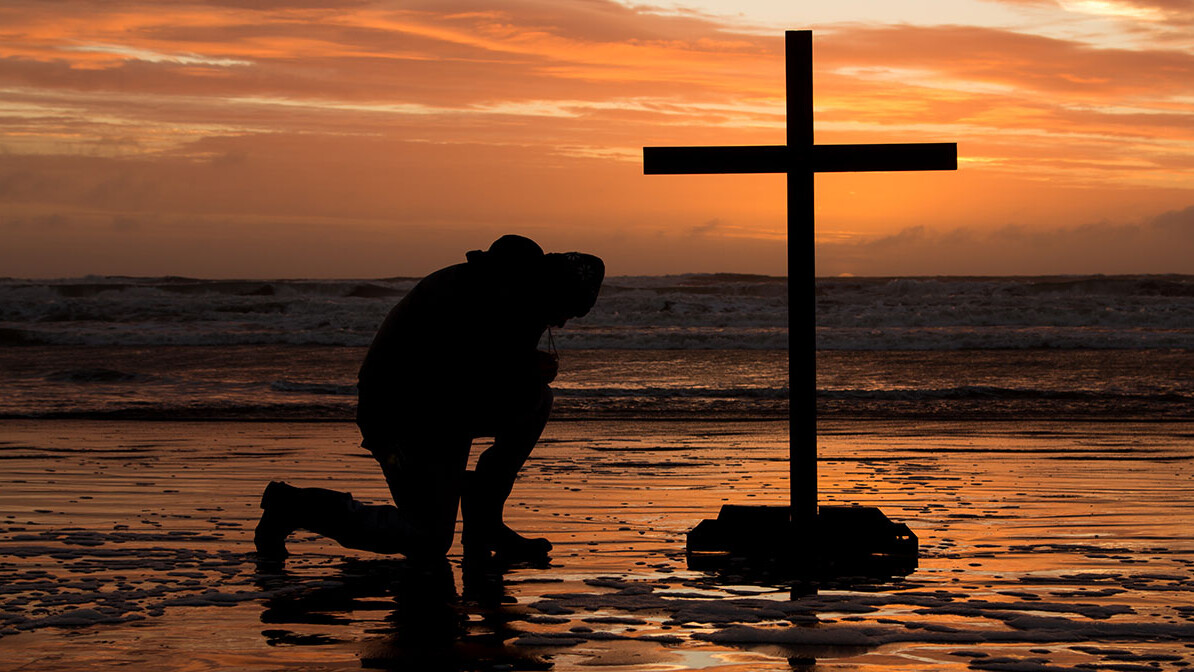
Come
 Excerpt taken from How to Stay Standing: 3 Essential Practices for Building a Faith That Lasts by Alli Patterson
Excerpt taken from How to Stay Standing: 3 Essential Practices for Building a Faith That Lasts by Alli Patterson
Chapter 1
Come
I saw the little red light blinking as I walked by. The only reason I stopped at the guest bedroom that day was to push the button on the answering machine. I listened as my mother-in-law finished her voice message like a letter. Just as I heard, “Love, Mom,” I glanced down at the old wood Home Depot cube that was still holding some random books from its former days as my college nightstand. I noticed my old Bible with a green pleather cover. For some reason I reached down; it had been in the same spot for so long the fake leather stuck to the inside of the cube as I tugged it out. I laid down across the bed, propped myself up on one elbow, and opened it. All I remembered of the Bible was the four names of the Gospels and that the red words were Jesus talking. I reread the handwritten note across the title page from my childhood best friend Amy. She had given me this Bible in our late teen years—maybe for a birthday or my graduation. It was inscribed in gold on the front cover with my maiden name, Alli Simpkins. I ended up using that same Bible for years to come—so long that my coworkers in my first ministry job used to call it the “Alli Simpkins Bible.” But that day when I found it again, I was coming to it for the first time in a long time. Things were not very good. My marriage was distant and in recovery. I’d burned a lot of bridges. I needed a friend. Jesus used to feel like one years before that; maybe that was why I picked up the Bible that day. Was Jesus still around? How could I find him if he was?
For reasons unknown, I said to Jesus in the guest room that day, “I’m here. Are you still here? Will your words help me?” I hadn’t come to him in so long that I forgot what it felt like to hear his voice, so I wasn’t surprised at the silence in return. I felt a little sad as I flipped through, realizing whatever I used to know of it was gone. But as I laid there in our old-stuff-from-college room, I was genuinely open. Hoping. Willing. I had no idea that’s all he really wanted, that I’d already begun the digging that was going to lay a new foundation.
“Come to me” is Jesus’s invitation. In the parable of the wise and foolish builders, Jesus said: “As for everyone who comes to me and hears my words and puts them into practice, I will show you what they are like. They are like a man building a house, who dug down deep and laid the foundation on rock” (Luke 6:47–48). Coming to Jesus is the very first rhythm of building a faith that lasts. Sometimes Christians talk about when they came to Jesus, meaning the point in time when they first understood the gospel and received the forgiveness for sin and new life available in Christ. That is a huge moment of coming to him, but it is really just the beginning of a lifetime of coming back again and again.
Coming to Jesus isn’t a one-time deal; it’s the ongoing, regular practice of bringing yourself before him, open and ready to take whatever he might have to give. Jesus spoke this invitation into a huge crowd on the day he shared that parable. It was a crowd seated on the grass and large rocks around him, listening to his teaching. This begs the question: Hadn’t they already come? The people he said this to were sitting right there, surrounding him. Jesus could have only meant that coming wasn’t primarily a physical act but something else altogether.
I’m sure you’ve been in meetings at work or in classes at school where people talk about things. In those kinds of meetings, I multitask. I keep one ear open while answering my emails on my phone. I’ve come, but barely. Jesus drew that same line with his words to that crowd. He made a distinction between being physically present and being open and willing to engage wholeheartedly. The crowd around Jesus was present, but most of them hadn’t yet come to him. He was after much more than sitting there with a head nod of interest while the crowd went about other things. He was looking for people who said, “Here’s all of me. So where do we go from here?” When Jesus gave the Sermon on the Mount that day, he invited everyone, even though he knew not everyone would be willing. The second builder in his parable did not come. That guy started with only hearing the words. It was as if he was sitting there but was engrossed in checking his email. It does not go well for that guy in the parable. To stay standing, it requires the depths of the heart.
As for everyone who comes to me and hears my words and puts them into practice, I will show you what they are like. They are like a man building a house, who dug down deep and laid the foundation on rock. When a flood came, the torrent struck that house but could not shake it, because it was well built. But the one who hears my words and does not put them into practice is like a man who built a house on the ground without a foundation. The moment the torrent struck that house, it collapsed and its destruction was complete. (vv. 47–49, emphasis mine)
To come is to bring the fullness of yourself—not just your body, but your heart and soul and mind as well. This was not an idea that started with Jesus’s life on earth. God had been telling his people that he wanted their hearts from the beginning. This is shown in the traditional daily prayer in ancient Hebrew culture called the Shema in Deuteronomy 6:4–5: “Hear, O Israel: The Lord our God, the Lord is one. Love the Lord your God with all your heart and with all your soul and with all your strength.” It was this idea that Jesus meant when he said, “Come to me.” He meant bring it all.
“Come” is not just an invitation; it’s also a command. Jesus repeated these words in Mark 12 when he was asked by a teacher of the law to confirm which was the greatest commandment. He answered with “Love the Lord your God with all your heart and with all your soul and with all your mind and with all your strength” (v. 30). If you want to find and follow Jesus, his command is to come and bring it all. “Come” is the one-word command Jesus issued to multiple people in the Scriptures who wanted to become his disciples. The implications of this word carry the hint of a challenge. If you want to be a follower of Jesus, I think he’d say, “Great. I’ll take your whole self and nothing less.”
The day Jesus told the parable of the wise and foolish builders, he implied that just sitting on nearby rocks wasn’t enough. As you know if you’ve ever been dragged to church by someone, being in a place where people talk about Jesus is not the same as coming to him yourself. The Bible contains a lot of religious types who spent their whole lives trying to get close to God in a church-like setting, keeping church-like rules, and then completely missing Jesus right in front of their own eyes. You could spend years being in the crowd at a spiritual place and never live a life grounded on Jesus. I’m pro going to church because many of them are environments that open our hearts and minds to God. I’ve certainly come to Jesus during a church service, but it happens much more often in my everyday life. Coming is personal. It’s between you and him. It’s entirely about the position of your heart and your willingness to dig deep for an authentic exchange with a living God.
When I think about the moments I have truly come to Jesus, they’re wildly different—all over the map. Sometimes I’m sad. Sometimes it’s a Wednesday at 6:15 a.m. with my favorite coffee mug in hand. Sometimes I’m standing in awe of something he created. Sometimes I have had a question or an idea that I just can’t get rid of, and I finally ask him about it. Sometimes I’m singing words in my car at the top of my lungs on the highway in response to him. Sometimes I’m discouraged or rejected. Sometimes I’m desperate or trapped at a dead end of my own bad choices. Sometimes I’m literally on my knees. Whatever the emotion or life scenario, they all have one thing in common: I’m ready to hear what Jesus has to say. And I just tell him that.
Sometimes coming to him sounds like, “Good morning. I’m here to be with you.” Sometimes it’s a frustrated, “Where do I go now?” Sometimes it’s a little giggle of joy at an inside joke between us. Sometimes it’s a weary, “What do I do with this?” Or an angry, “Say something!” Or a wordless sigh. Or a pent-up feeling of finally giving words to something I was resisting admitting out loud. When I genuinely come, I open myself up to the idea that Jesus has something for me in that place. And I also have to risk that he’ll stay silent.
I’ve caught myself staying away from him because of this risk: I’m afraid I’ll open myself up and come and there will just be . . . crickets. Other times I’ve held Jesus at arm’s length because I knew what his words said about something, and I didn’t want to hear it. Sometimes I don’t come to him because I just forget I can. Sometimes it’s because I’m afraid he’ll be mad at me or be mean to me. Sometimes I stay away because I am not done trying to do it my way.
I tried the “avoid Jesus” approach until the day I threw myself down on the leather love seat in my bedroom. I had taken a new and significant leadership role on staff at the church. I took it because I was a good leader. I took it because I was asked. It had only been about four weeks since I’d started when I had a dream about being way up high on a very rickety platform. I had awakened to a sense that something was very wrong with the job. In the few weeks that followed, I had another dream about it and a growing sense that I needed to get out of this job. I couldn’t shake the thought. I couldn’t escape the urgency. I tried every which way in my mind to justify staying in it. Who leaves a job they just got? How bad does that look? When I threw myself onto the love seat that day, it was me coming to Jesus. I hadn’t been ready before that. I hadn’t been open to all possibilities, and I knew it. But that day I came. I was ready to figure out what in the world I was going to do. I was ready to admit that I’d potentially made a mistake. I was ready to ask questions, and I was open to the answers. I came out of my resistance and avoidance and came to Jesus instead. I was finally over the voice in my head that said, “Give it a while and see if it gets better.” I came to Jesus saying, “Okay, okay, I give up. I’m here. Where do we go from here?”
We all have doubts about whether God’s going to be there. We all have fears about what he might ask us to do. We all have weird baggage from our preconceived notions of what it means to live a life following him. Whatever your halfways and hang-ups, bring them along. Don’t let them stop you from coming. A word of warning: there’s no faking this. And this isn’t a performance for anyone else. God knows if you’re all there or if you’re holding something back from him. To come is an internal, invisible reality, but it’s a reality nonetheless. If you want a foundation of faith that lasts, it has to be with a God who can handle the real you. That’s exactly who you’ll find waiting for you when you show up. So, come.
Show up.
Tell the truth.
Kneel down.
That’s how you come.
…
Alli Patterson, How to Stay Standing: 3 Essential Practices for Building a Faith That Lasts, Revell, a division of Baker Publishing Group, 2023. Used by permission.
Order your copy of How to Stay Standing: 3 Essential Practices for Building a Faith That Lasts by Alli Patterson
Trending Now
Sign up today for your Inspiration Today Daily Newsletter
Supercharge your faith and ignite your spirit. Find hope in God’s word. Receive your Inspiration Today newsletter now!
Alli Patterson
Alli Patterson is passionate about helping others build a life on the firm foundation of Jesus's truth and grace. She holds a master's degree in biblical studies from Dallas Theological Seminary and is a teaching pastor at Crossroads Church. She lives with her husband, Bill, their four children, and one very bratty cat. Alli is a fan of Mexican food, Ohio State football, geeky Bible maps and timelines, pedicures, long runs, and good books. Learn more at theallipatterson.com
Related Articles
December 28, 2025
3 Steps to Becoming a Hero of Faith
The Bible tells the stories of dozens of people who seemed unlikely to ever do anything great. Many…
December 27, 2025
Praying God’s Word
Praying God’s Word is more than a spiritual exercise—it is a transformative practice that deepens…
December 26, 2025
Good Without God? Why Being Nice Won’t Get You Into Heaven
Can someone be good without God—and is goodness enough to get us into Heaven? Our culture loves the…
December 19, 2025
Reacting to Change
Reacting to change can feel overwhelming when life shifts faster than we can adjust, leaving us…
Next Steps To Strengthen Your Walk
Inspiration Today Newsletter
Supercharge your faith and ignite your spirit. Find hope in God’s word. Receive your Inspiration Today newsletter now!
Christian Articles
Find articles to strengthen your walk and grow your faith. We have a wide range of topics and authors for you.
Submit A Prayer Request
We are here for you. Simply click on the button below to reach us by form, email or phone. Together we will lift our hearts and voices with you in prayer.





